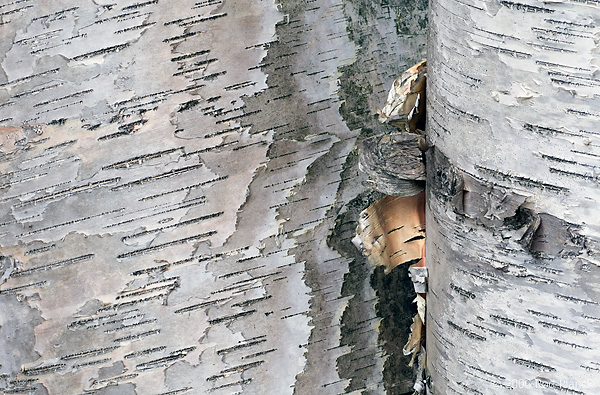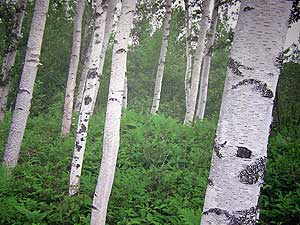Paper Birch Tree Biography
The Paper Birch (Papyrifera) is generally described as a perennial tree. This is native to the U.S. (United States) has its most active growth period in the spring and summer . The Paper Birch (Papyrifera) has green foliage and inconspicuous yellow flowers, with an abuncance of conspicuous brown fruits or seeds. The greatest bloom is usually observed in the mid spring, with fruit and seed production starting in the summer and continuing until summer. Leaves are not retained year to year. The Paper Birch (Papyrifera) has a short life span relative to most other plant species and a rapid growth rate. At maturity, the typical Paper Birch (Papyrifera) will reach up to 70 feet high, with a maximum height at 20 years of 40 feet.
The Paper Birch (Papyrifera) is easily found in nurseries, garden stores and other plant dealers and distributors. It can be propagated by bare root, container, cuttings, seed. It has a rapid ability to spread through seed production and the seedlings have medium vigor. Note that cold stratification is not required for seed germination and the plant cannot survive exposure to temperatures below -62°F. has low tolerance to drought and restricted water conditions.
Economic: White birch wood is used commercially for pulpwood, plywood, veneer, and turnery. Tree chips are used for paper manufacture and fuel.
Medicinal: A decoction has been used to treat dysentery, various diseases of the blood, induce sweating, and to ensure an adequate supply of milk in nursing mothers (Moerman 1998). Birch gum could have been medicinal for some stone-age gathers. The chewable gum contains zylitol, a disinfectant, and some terpenes, which could give the chewier a mild buzz (MacKinnon & Pojar 1994).
Landscaping & Wildlife: Betula papyrifera is commonly used as a landscape tree for it’s striking coloration. It is a desirable ornamental to be planted around homes and public buildings, in parks, and on campuses. Moose, snowshoe hare, and white-tailed deer browse paper birch. Numerous birds and small mammals eat the buds, catkins, and seeds.
Agroforestry: White birch is used in forested riparian buffers to help reduce stream bank erosion, protect aquatic environments, enhance wildlife, and increase biodiversity.
The Paper Birch (Papyrifera) is generally described as a perennial tree. This is native to the U.S. (United States) has its most active growth period in the spring and summer . The Paper Birch (Papyrifera) has green foliage and inconspicuous yellow flowers, with an abuncance of conspicuous brown fruits or seeds. The greatest bloom is usually observed in the mid spring, with fruit and seed production starting in the summer and continuing until summer. Leaves are not retained year to year. The Paper Birch (Papyrifera) has a short life span relative to most other plant species and a rapid growth rate. At maturity, the typical Paper Birch (Papyrifera) will reach up to 70 feet high, with a maximum height at 20 years of 40 feet.
The Paper Birch (Papyrifera) is easily found in nurseries, garden stores and other plant dealers and distributors. It can be propagated by bare root, container, cuttings, seed. It has a rapid ability to spread through seed production and the seedlings have medium vigor. Note that cold stratification is not required for seed germination and the plant cannot survive exposure to temperatures below -62°F. has low tolerance to drought and restricted water conditions.
Economic: White birch wood is used commercially for pulpwood, plywood, veneer, and turnery. Tree chips are used for paper manufacture and fuel.
Medicinal: A decoction has been used to treat dysentery, various diseases of the blood, induce sweating, and to ensure an adequate supply of milk in nursing mothers (Moerman 1998). Birch gum could have been medicinal for some stone-age gathers. The chewable gum contains zylitol, a disinfectant, and some terpenes, which could give the chewier a mild buzz (MacKinnon & Pojar 1994).
Landscaping & Wildlife: Betula papyrifera is commonly used as a landscape tree for it’s striking coloration. It is a desirable ornamental to be planted around homes and public buildings, in parks, and on campuses. Moose, snowshoe hare, and white-tailed deer browse paper birch. Numerous birds and small mammals eat the buds, catkins, and seeds.
Agroforestry: White birch is used in forested riparian buffers to help reduce stream bank erosion, protect aquatic environments, enhance wildlife, and increase biodiversity.
Paper Birch Tree
Paper Birch Tree
Paper Birch Tree
Paper Birch Tree
Paper Birch Tree
Paper Birch Tree
Paper Birch Tree
Paper Birch Tree
Paper Birch Tree Video
Paper Birch Tree Project







No comments:
Post a Comment